
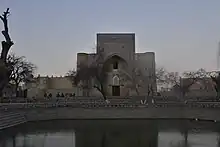
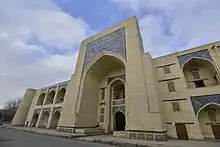
Lab-i Hauz (Uzbek: Labihovuz, Tajik: Лаби Ҳавз, romanized: Labi Havz, Persian: لب حوض, romanized: Lab-e Howz, meaning in Persian "by the pool"), sometimes also known as Lyab-i Khauz, a Russian approximation, is the name of the area surrounding one of the few remaining hauz pools that have survived in the city of Bukhara, Uzbekistan. Until the Soviet period, there were many such pools, which were the city's principal source of water, but they were notorious for spreading disease and were mostly filled in during the 1920s and 1930s.
The Lab-i Hauz survived because it is the centerpiece of a magnificent architectural ensemble, created during the 16th and 17th centuries, which has not been significantly changed since. The Lab-i Hauz ensemble, surrounding the pool on three sides, consists of the Kukeldash Madrasah (1568–1569, the largest madrasa in the city), on the north side of the pool, and two religious edifices built by Nadir Divan-Beghi: a khanqah (1620; Uzbek: xonaqah, meaning a lodging house for itinerant Sufis) and a madrasa (1622), which stand on the west and east sides of the pool respectively. The small Qāzī-e Kalān Nasreddīn madrasa (now demolished) was formerly located beside the Kukeldash madrasah.[1]
History
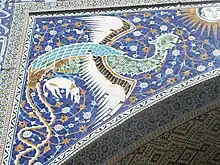
The history of this ensemble is closely connected with the name of Nadir Divan-Beghi, who was an important grandee, vizier, and also an uncle of the Emir of Bukhara Imam Quli Khan. It is said that when Nadir Divan-Beghi built the khanqah which bears his name, near the site of the building there was a large holding owned by an old Jewish widow. (There was a substantial population of Bukharan Jews.) Nadir Divan-Beghi had decided that this site would be the perfect place for a pool, but the widow turned down his offer to buy the property. Then Nadir Divan-Beghi brought her before Imam Quli Khan in the hope that the Emir would coerce her into selling. The Emir of Bukhara ordered a congress of muftis to inquire into the question. However, these specialists in Muslim law decided that there was no legal way to purchase the property, other than with the widow's consent, since Jews had rights on a par with Muslims if they paid the Jizya or poll-tax on non-Muslims.
So, Nadir Divan-Beghi had to build a small reservoir near the house of that stubborn Jew. But he dug an aryk, an irrigation ditch, to his new pool in such a way that the water ran right near her house, although it was more expensive. Soon the water began to undermine the foundations of the widow's house. When she came to Nadir Divan-Beghi for justice, he confirmed his readiness to buy her house for a fair price. But widow rejected the money, laying down her own conditions instead. She promised give up her property if the Bukharan rulers would give to her another piece of land with permission to build a synagogue. In return for the widow’s holding Nadir Divan-Beghi gave her a plot of land, belonging to him, in a residential area, which later was named the Jewish quarter (Mahalli Kuma).
Soon the first synagogue at Bukhara and a large pool were built. People started to call it Lab-i Hauz (see picture), which means in Persian "by the pool". The date of its construction is about 1620. But folk memory still retains another epithet – Hauz-i Bazūr, "pool made with force".
Kukeldash Madrasa (1568/1569)
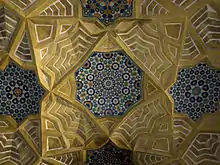
The madrasa is the oldest building of the ensemble. It has 160 cells, located in two stores on the perimeter of a two iwans yard. The traditional facades of the madrasah are adorned with majolica.[2] Over its history, the madrasa performed many different roles: it served as a caravanserai and defensive fortress, and even as a place of execution. Today a section of the madrasa is a museum dedicated to the writers Sadriddin Ayni and Jalol Ikromiy.[3]
Khanqah of Nadir Divan-begi (1619/20)
Nodir Devonbegi Khanqah is a rectangular edifice topped with a dome. The building has non-traditional narrow and prolate main portal along with two lateral entrances. The hall (dhikr-khana) has excellent acoustic properties. The inner walls of the hall are recessed with niches fringed with stucco moldings. The dwelling space occupies corners and lateral exterior walls of the building. The finishing of the main entrance gate is made quite conservatively, with an exception of some floral elements in ornamentation. The edges of the main portal are overworked with epigraphy ornaments. The main front of the khanqah is cornered with towers cut at a level of the walls. Due to its location and size (side of the square hall is 11,2 m. - 36,75 ft.), the khanqah was the prominent cultural and religious centre of Bukhara.[4][5]
Madrasa of Nadir Divan-begi (1622/23)
Divan-begi is a title that designated the post right after khan in the Bukhara khanate. Nadir Divan-begi held this position during the reign of Imam Quli-khan (1611-1642), the strongest khan of the Ashtarkhanid (Janid) dynasty (established in 1599). The devotion to Islam tradition in the state under Janid dynasty was pale before the eagerness of the time of prominent Shaibanid khans. These two important peculiarities of the power were soon expressed in remarkable architecture tendency. In 1619 Yalantush-biy who virtually independently governed Samarkand had begun the construction of Sher-Dor Madrasah. The rich colored finishing and the depiction of sun, tigers and antelopes tell of a pioneering approach to artistic expression, unique in the Islamic world. In three years Nadir Divan-begi had followed Yalantush-biy by construction of his own revolutionary structure (Nadir Divan-Begi Madrasah). The entrance portal has depictions of two simurgh carrying white deer, and a "man-in-the-sun" face. [6][7]
Maghoki Attori Mosque
Before the construction of the first synagogue Jews had shared a place in a mosque with Muslims. This mosque was called Masjed-e Maghākī-ye Attārī (see picture), i.e. "the mosque in a pit in the perfume market". Some say that Bukharian Jews and Muslims worshipped alongside each other in the same place at the same time. Other sources insist that Jews worshipped after Muslims.
Before the Arab conquest there was a bazaar on the site of Maghoki Attori. It was a market for idols, potions and spices – attar (perfumes) and other goods. Besides this, there was formerly a Temple of the Moon (Mah) close to this place. Narshakhi, in his History of Bukhara (ca. 950), named the mosque built on the site of the former temple "maghākī", i.e. "in a pit", because even then half of it was concealed from view by the rising soil level.
Other details
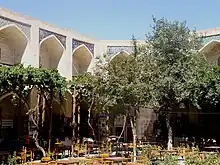
Today the Lab-i Hauz is a right-angled pool (46 x 36 meters), which stretches from the east to the west and is buried in the verdure of century-old trees. Its edges are arranged in the form of the descending staircase made of massive blocks of yellowish limestone.
As stated above the Kukeldash Madrasa is the biggest in Bukhara (80 x 60 meters). Kulbala Kukeldash ('the brother') was the name of the Emir's foster-brother who was the builder of this structure.
The Nadir Divan-Beghi Madrasa was initially erected as a caravanserai. At the inauguration ceremony Imam Quli Khan unexpectedly proclaimed the supposed caravanserai is to be a madrasa. So Nadir Divan-Beghi was obliged to rearrange the caravanserai by adding on to the front the loggias, the portal (Aywan) and angular towers. He also constructed an additional storey with cells.
The Nadir Divan-Beghi Khanqah is located opposite the Nadir Divan-Beghi Madrasa on the western side of the Lab-i Hauz.[8]
References
- ↑ "Lyabi-Hauz | Caravanistan". Caravanistan. Retrieved 2018-02-03.
- ↑ Lukonin, Vladimir; Ivanov, Anatoly (15 September 2015). Central Asian Art. ISBN 9781783107971.
- ↑ Kukeldash Madrasa Retrieved 2021-09-03.
- ↑ "Бухоро Bukhara Бухара" На узбекском, английском и русском языках. Издательство "Узбекистан", Ташкент 2000
- ↑ Dmitriy Page. "The Khanaka of Nadir Divan-begi". Retrieved October 14, 2014.
- ↑ Dmitriy Page. "Impact of Nadir Divan-begi". Retrieved October 14, 2014.
- ↑ История Узбекистана (XVI - первая половина XIX в.) Ташкент -"Укитувчи" -1995
- ↑ "Lyabi-Hauz | Caravanistan". Caravanistan. Retrieved 2018-02-03.
.jpg.webp)